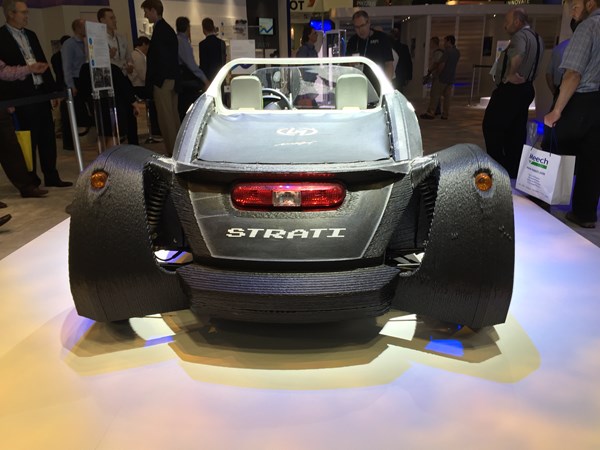Sabic expands its focus in additive manufacturing technology
Sabic is expanding the company’s application development focus in additive manufacturing technology.

Proof there is at least one guarantee in life: when you have a 3D-printed car at your booth, it’s going to generate quite the crowd. For instance, during NPE2015, Sabic (S-19001) is proudly displaying the Strati, the world’s first 3D-printed car. Using one of Sabic’s carbon fiber filled compounds, Local Motors was able to demonstrate the potential of additive manufacturing as a process technology that can shorten product development time, reduce prototype costs and enable greater design freedom.
And seeing the tremendous market potential, Sabic is expanding the company’s application development focus in additive manufacturing technology.
“We understand the need in the marketplace,” Tony Cerruti, marketing director of the Americas for Sabic told Plastics Technology. “The technology is opening up new capabilities, which is allowing the design freedom to create parts.”
Sabic says that its experience in additive manufacturing across a number of industries will enable it to work closely with technology innovators including universities, research laboratories, printer manufacturers, OEMs and emerging technology companies to help accelerate the advancements necessary for additive manufacturing to reach its full potential. Sabic’s investment in several industrial and desktop printers, including the Big Area Additive Manufacturing (BAAM) printer used to print the world’s first 3D-printed car, will help to facilitate process improvements in fused deposition modeling (FDM) and other extrusion-based printing processes.
Part teardown, concept creation, mechanical design, CAE analysis, material evaluation, part performance simulation, testing and advanced processing techniques are capabilities already in use at Sabic’s technology centers to serve multiple industries. For instance, in a recent project to search for innovation and efficiencies in luminaire design and production, Sabic used predictive engineering and 3D printing technology to create an integrated thermoplastic LED luminaire, highlighting the opportunity to reduce the number of parts by 84%, the total weight by 24% and assembly time by 65%, compared to a conventional metal luminaire.
Sabic offers a range of materials for use in additive manufacturing today including:
- ULTEM 9085 resin most commonly used for aerospace applications. On display in Sabic’s booth is a 3D-printed economy class aircraft seat created as inspiration for future seat design and manufacturing methods.
- LNP THERMOCOMP compounds – a carbon fiber reinforced material most recently used in the printing of Local Motors’ Strati vehicle.
- CYCOLAC MG94 resin – an ABS material used by the maker community for fused filament fabrication (FFF) printing.
“We are showing real examples at our booth to help customers rethink how they might build a product,” Cerruti said. “Additive manufacturing is not just hype, the industry sees the potential.”
















